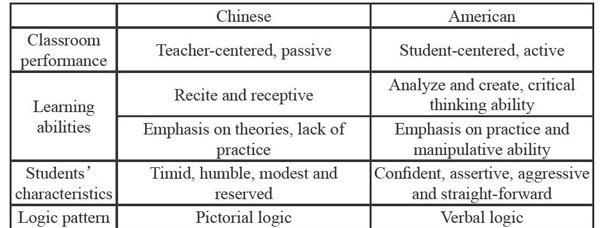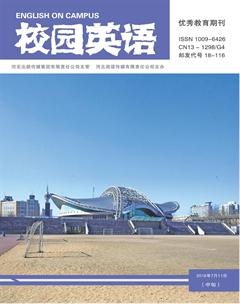Chinese Traditional Learning Habit and Its Influence on English Teaching and Learning in China
程蕾
【Abstract】In order to fully understand Chinese traditional learning habit, it is necessary to know what it is and what its historical development is and how to connect it with cultural, political and social development in China. When it comes to English teaching and learning, Chinese traditional learning habit indeed exerts a far-reaching effect on both teachers and students.
【Key words】Chinese Traditional Learning Habit; English teaching and learning in China
Chinese traditional learning habit, which is influenced by its cultural, political and social development, has exercised a deep effect on English teachers and students in China. The manifestations are students learning motivation, teachers methodology, and their selection of learning materials.
One Definition of Chinese Traditional Learning Habit
To fully understand Chinese traditional learning habit, it is of great importance to make a contrast between Chinese and American students. The following table is a brief summary.
Through the above contrast, we can see some features of Chinese traditional learning habit: traditional Chinese classroom is teacher-centered. Teachers are the authority of classroom; they control the content and rhythm of classes. Usually what they teach is what students should learn. Students are passive learners who only receive and recite the knowledge imparted by teachers and seldom exercise their own brain to explore and create knowledge, thus they are lack of analytical ability, critical thinking ability and creative ability. What they are good at is reciting ability, capacity of imitation and accumulation. Students are like solders of an army, neat and uniform, without unique personalities. In specific, they carry forward the old tradition and knowledge and seldom set doubt on authorities. Passive reception is the main theme of classes.
Two Cultural Factors: China is a traditional country with a time-honored history. Some core cultural values can be traced back to Confucianism, which is the philosophical foundation for education in China.
According to Confucius, learning is the accumulation of knowledge and the reading of books and reviewing is an indispensable part of learning process, all of which influence the formation of traditional learning habit: recitation, repetition and diligence. Confucius once said, “Study as if you never to master it, as if in fear of losing it” and “By reviewing the old, one learns the new.” Moreover, Confucius regards a good teacher as a model for people to follow, a person passing on knowledge and a guider showing students through the door. So teacher is a highly respected profession in China and students often pay high regards to their teachers. Besides, Confucius emphasizes on learning from ancestors by internalization of their wisdom and by emulation. Therefore, the characteristics of traditional Chinese students are modest, careful, reserved and self-restrained. To them, these characteristics are the manifestation of cultivation. When it comes to education, they are afraid of showing personality and originality. Usually a student is not expected to present his or her own ideas at least until he or she has mastered sufficient of the body of knowledge to be able to make informed judgments.
Three Political Factors: Since ancient times, in order to enhance the centralization of authority and prevent the potential uprisings, emperors of different dynasties do all they can to control the thoughts of intellectuals, which indirectly exerted an influence on the formation of traditional learning habit, which is conservative and passive.
1. In Qin dynasty, Emperor Qin carried out a large scale campaign, called burning of books and burying of scholars. He first burned books of the other six countries to unify the peoples thoughts for unification, and then he buried many mountebanks and Confucius scholars for they are the only people who are capable of overturning his governance. Emperor Qins practice was indeed a great help in maintaining his governance and realization of unification for first time in history. However, its negative consequence is that it set constraints on intellectuals thoughts.
2. During Tang Dynasty, Imperial Examination took its shape and since then every dynasty retained the system of examination. The exam form is rigid and conventional, which, in turn, fossilizes the traditional learning habit.
3. In the dynasty of Ming and Qing, the negative influence of Imperial Examination on controlling intellectuals thoughts came to the climax. The most eminent evidence is literary inquisition (imprisonment or execution of an author for writing something considered offensive by the imperial courts) held by several emperors in Qing dynasty. There are examples of Emperor Shunzhi: the Case of Ming Dynasty History and Emperor Kangxi: the Case of Nanshan Collection.
4. In modern China, government also uses the system of test to serve the purpose of nation-building. With an ideology based on collectivism, the communist party in China creates an educational atmosphere in which students, unobtrusively and imperceptibly, conform to the conventions of traditional learning habit. “Teaching-to-the-test” phenomenon is prevalent in China. Schools syllabus is mostly test-based due to the influence of old tradition of memorizing and recitation. Take English class as an example, attention is often paid on grammar and accuracy-based tasks. The usage of English as a communication tool is neglected.
Four Social Factors: China is a country with a large population and plenty of social factors also exercise an influence on the formation of Chinese traditional learning habit. First of all, the large population of Chinese students, the relatively small population of qualified English teachers and inadequate monetary fund make it impossible to teach students in small-scaled classrooms, so it is difficult to take consideration of every students personality and development. Moreover, Teachers teaching emphasis is to impart knowledge and what students need to do is to receive, so this kind of teaching does not need small classes to carry out discussions. Finally, the competition among Chinese students is fierce. They have to compete for eminent high schools, excellent colleges, and professional jobs. So their learning motivation is often instrumental-motivated, which in turn accelerates the formation of traditional learning habit. According to a survey conducted by Derek and Sylvia (2001), 71.8 percent of British-Chinese pupil respondents prefer subjects where they have to memorize facts than where they have to solve problems. Likewise, more than three-quarters of British-Chinese respondents (86.2%) indicate they learn best when they memorize things by heart.
Five Traditional Chinese Learning Habit Has Influenced English Learners Learning Motivation, Teachers Methodology and Their Selection of Learning Materials.
1. Chinese students learning motivation is instrumental and extrinsic, which is not conducive to their English learning in the long run. Many English learners set English as an instrument, with which they can pass an exam or find a good job in future. They are compelled to learn English. This is different from the real English learners who have a passion for learning and want to integrate into the target culture and enhance personal development. As the above “teaching-to-the-test” phenomenon shows, plenty of tests and fierce peer competition result in the fact that English learners pay most of their attention to homework and tests; they seldom have the time and energy to really stop to appreciate the beauty of English. In addition, the general language environment in China is Chinese, so learners can not feel the real communicative need of learning English and this is an important factor for their instrumental motivation.
2. The teaching methodology is typical of teacher-centered and students are passive recipients. In the traditional English classroom, grammar translation is still preferred. Grammar and vocabulary are the emphasis of classes. Furthermore, learning activities are passive and conservative. Based on the behaviorism, audio-lingual method has always been popular in China. The feature of language acquisition is concentrated on intensive reading, memorization and rote learning. Communicative skills and cultural assumptions are largely overlooked.
3. The selection of learning materials is usually vocabulary-grammar based, unauthentic and outdated. On the one hand, many English textbooks attach great importance to the knowledge of vocabulary and grammar and neglect the cultural information; such practice is not conducive to the comprehensible development of English learning. On the other hand, the unauthentic and outdated knowledge exercises a negative effect on students mastery of communicative language used in daily life by native speakers and prevent the formation of their intuition of using English.
Six Conclusion
Influenced by cultural, political and social development in China, the Chinese traditional learning habit has exercised a far-reaching influence on English teaching and learning in China. Most of what I analyze here is related to the negative influence. However, Chinese traditional learning habit indeed has positive effects on English learning in China. For example, many Chinese students have a good mastery of vocabulary and grammar, which lays a solid foundation for their English writing. Therefore, to deeply understand Chinese traditional learning habits influence on English learning in China, we should adopt a comprehensive perspective.
References:
[1]Derel Woodrow and Sylvia Sham(Yuen Mei).(2002).Chinese Pupils and Their Learning Preferences.Race Ethnicity and Education,Vol.4,No.4,2001.
[2]Doug Absalom and Tang Degen.(n.d.).Teaching Across Cultures:Consideration for Western EFL Teachers in China.Journal of Teaching Across Cultures,124,12—16.
[3]Literary Inquisition.(n.d.).Wiki.Net.Retrieved Oct 20,2010,from http://zh.wikipedia.org/zh/%E6%96%87%E5%AD%97%E7%8D%84.

